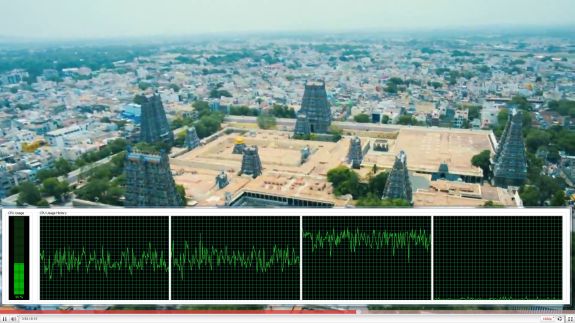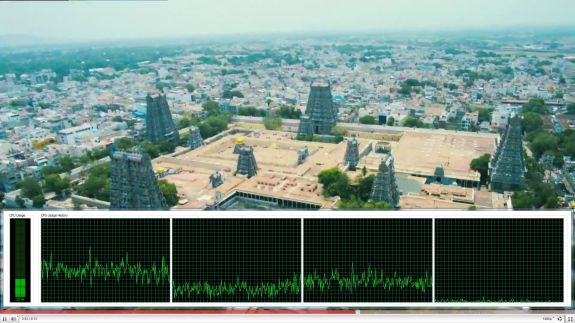ASRock Core 100HT-BD : Bringing HTPCs to the Mainstream Market [UPDATED : Noise Issue]
by Ganesh T S on July 19, 2010 9:34 PM EST- Posted in
- Home Theater
- Arrandale
- ASRock
- Media Streamer
- Core i3
- HTPC
The Core 100 HT-BD is well off from the networking perspective. It really doesn't matter if the unit is within reach of a wired network or not. We carried out all our tests with a 150 Mbps Draft-N wireless network. Despite being unable to utilize the maximum transfer rates available on the Core 100 HT-BD, we were easily able to stream HD clips of more than 50 Mbps. HD YouTube videos and HD Netflix streaming had no issues.
While on the topic of network streaming, let us take a brief look at how the system performs while accessing online video services. The first set of screenshots below show the CPU usage while playing back a 1080p YouTube video with and without hardware acceleration enabled. As can be seen, the GPU indeed supports Flash acceleration. Enabling hardware acceleration almost halved the CPU usage. Dedicated GPUs from ATI and Nvidia might result in lesser CPU usage. However, one is not really upset at having just 20% CPU utilization for a 1080p HD video. We expect similar results for videos on Hulu.
Netflix streaming, on the other hand, uses Microsoft's Silverlight technology. Unlike Flash, hardware acceleration for the video decode process is not controlled by the user. It is upto the server side code to attempt GPU acceleration. Thankfully, Netflix does try to take advantage of the GPU's capabilities. This is evident from the A/V stats recorded while streaming a Netflix HD video at the maximum possible bitrate of 3.8 Mbps. While the video is definitely not 1080p, we observe that the CPU utilization of around 30% is higher than the CPU usage for a 1080p YouTube video.
We suspect that the handling of the DRM in the case of Netflix streaming is done by the CPU, resulting in the higher usage. In any case, 30% CPU utilization for streaming the highest bit rate Netflix videos is not bad.
Users of media streamers streaming online videos often have to put up with messages of the sort 'This content is not available on TV connected devices' or need to queue up the videos on a PC before accessing them through their media streamer box. HTPC users don't need to worry about any such limitations. On the whole, the Core 100 HT-BD is a big winner from the network streaming standpoint.













107 Comments
View All Comments
ganeshts - Tuesday, July 20, 2010 - link
Shadowmaster625,This unit is slightly on the leading edge (The Arrandales were introduced around 6 months back).
With $100, it is difficult to get a notebook with HD audio bitstreaming and Blu-Ray drive, even second hand.
For the set of features it offers, we think it is a decent value for money. As for this being mainstream, I am sure there are many who spend $700 or so on a PC once every 4 - 5 years, and this is a perfect system for such people.
tmservo - Tuesday, July 20, 2010 - link
Pray tell.. if you've got a way to get a case/motherboard/ram/hdd/bluray drive and get 1080P for under $100, I'm interested. Somehow, I don't see that as at all feasible. Hell, even the cheapest AMD CPU + board and a cheap case alone is $100. So, however you shoe horn in all those other components, or then get the software to run them (supplied here) ..But, if you'd like.. give me a part list of what you can get that anyone could go buy, NEW, for $100.
Or, find me a used laptop on Ebay with HDMI output that does 1080P and has a bluray drive for $100. Even if it has no screen. Needs to have a HDD, Memory, BD drive though.. and function.
cjs150 - Tuesday, July 20, 2010 - link
53 db!! That is just plain daft.I suspect the design of the case does not help.
I have just built a mini-server using a Atom 510 and I am sure the M/B was ASrock, mini-itx format and a PCI-E slot. Easiest build I have done even though the case was not perfect. As a server it is effectively silent
I do not want an HTPC that creates any more noise other than maybe a slow running 140mm+ fan
ganeshts - Tuesday, July 20, 2010 - link
cjs150,Note that the 53dB is under full load, when all threads are pegged at 100%, and it is just inches away from the unit. The farther you are, the lesser it is, and at 8ft, it was barely discernible.
Under idle, the unit is advertised as having 25dB noise, measured in an anechoic chamber (Refer YouTube video from their marketing department).
I would say, for HTPC purposes, the noise from the unit is definitely within limits.
tech6 - Tuesday, July 20, 2010 - link
Nice work Ganesh - I look forward to further HTPC reviews to see how the AMD platforms compete.shamans33 - Tuesday, July 20, 2010 - link
Ganesh,I'm curious as to how the IR receiver is connected to the motherboard...USB and/or motherboard headers? Is it possible to do a force power off (if let's say the system is frozen) or to do a cold boot up?
Thanks for reviewing more SFF items.
ganeshts - Tuesday, July 20, 2010 - link
shamans33,I believe the IR receiver is connected to a dedicated NuvoTon chip on the motherboard.
The power off button on the remote puts the system in sleep mode when the unit is in operation. In my usage scenario, I had the AC adapter connected to the back of the unit, and the system was completely shutdown. The Power button on the remote was able to boot up the unit without issues (even with Instant Boot disabled).
johnspierce - Tuesday, July 20, 2010 - link
Hi Ganesh,Very nice review, extremely thorough, thank you!
I have a question about how the HDMI handshaking works with the ASRock.
I have built several HTPC's with both NVidia and ATI HDMI-out video cards and it seems they all have a problem when I have it plugged into my HDMI-switching Onkyo receiver.
When I switch from HTPC to DVR and don't change back for awhile, it always has a problem with the display coming "alive" on the switch back. Turning the monitor off and on re-establishes the handshake, but this is an annoying trait of the current crop of video cards. Does the ASRock have this problem?
Also, I wanted to "weigh in" on the lack of a TV tuner -- I really think this is quickly becoming a non-issue since I now use an OTA receiver for local HD and everything else gets streamed. TV Tuners will soon be an anachronism in my opinion.
Thanks,
John
ganeshts - Tuesday, July 20, 2010 - link
johnspierce,I have the same handshaking issue with my ATI based HTPC.
As far as I could see, I didn't have the handshaking issue with the ASRock setup, but the whole testing was done with 2 displays connected to it. I will do a 'standalone' test and get back to you on this.
Aikouka - Tuesday, July 20, 2010 - link
A very interesting product indeed, but I've got my own three cents to provide!1) The price. Ouch... when I first opened this review, I checked the Egg to see if they had them in. Of course as the review mentions, I ended up finding the DVD-equipped model for $650. Tack on another $130 for Windows 7 Professional (note, I use Pro since it enables remoting in, which I find indispensible for a HTPC) and you've got nearly $800. If the Blu-Ray-equipped model retails for $700, you get $830 with the OS and then you have to consider that the blu-ray playback software will set you back another $100 (unless you can find them on sale... TMT3 has been on sale for $75 before).
I've spec'd out a few HTPCs in my quest to find the Holy Grail of HTPC devices, and if price were my main concern, I'd still probably go with my own build. I never put my HTPCs to sleep, so I'm honestly not even worried about that aspect and I don't mind a slightly higher power consumption.
2) The VIA VT2020. Have you noticed a strange amount of memory use from having this? I have an ASUS P7P55D-E Premium motherboard, which also features the same VIA audio chip, and I have god awful levels of memory use from audiodg.exe (Window 7's audio "controller"). At one point before upgrading my BIOS, I would literally see 800MB of memory being used by it. Last night I checked and I had 130MB of memory being used and I only had a single mp3 open. The worst part is that the last time I checked, VIA does not provide audio drivers for that chip. On their website they said that it was manufactured specifically for ASUS and to check their website for drivers.
But who knows... the strange things I see are possibly just issues with the P7P55D-E Premium... it's a god awful motherboard that was released with buggy BIOS revisions and it's no wonder you can't even buy it from NewEgg anymore.
3) The Front. Why do people want to see things like USB ports, bright blue LEDs and 3.5mm ports on the front of entertainment center components? The worst offender of the "sleak front" has to be that ghastly Intel i3 Inside sticker. I'd rather the connections be hidden under some sort of flap or door if they absolutely have to be on the front.
4) The remote. As something to mention, when I was discussing HTPC stuff on the Anandtech forums, a user clued me in on a nice Gyration MPC-capable remote that you could buy off eBay (from Lenovo it looks like) for only $50 that provided some mouse support if you ever needed it. I have to say that I quite like it so far and it might be something to look into if you don't like IR remotes. The only negative aspect is the ugly and obtuse dongle.
5) The comparison. It'd be nice to see how this item really compares to it's cousin, the ATOM-based version. Given the blu-ray version is available for $500 on NewEgg, does it handle all the necessary playback? A $200 savings for slightly longer application loads might be somewhat advantageous. Right now, I literally just leave my HTPC turned on 24/7 with WMC loaded up, so other than any necessary start-ups/shut-downs, I may see very little difference with the ATOM version.